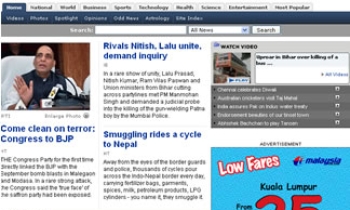Penn State University still offers classes in journalism and Ford Risley, the head of the journalism department, tells students that exciting changes are happening in the newspaper business where traditionally print-focused publications are posting stories online, setting up blogs and learning to podcast.
Yet living in interesting times isn't always the easiest thing to do as evidenced by the industry's own breaking news.
The Dallas Morning News yesterday announced voluntary buyouts of 111 newsroom employees, following similar steps earlier by the Washington Post, the New York Times and other publications. The cost-cutting moves followed steady industry circulation declines at a time when newsprint costs are climbing and advertising is shifting to other outlets.
"This has not been a good year for the newspaper industry," said John Morton, a newspaper industry analyst in Silver Spring, Md.
The industry is a still profitable one. Mr. Morton said newspaper operations of the public companies that report such information had an average profit margin of 18 percent in the first six months of the year.
But pressure is on as companies seek to battle profit erosion by adapting to new competition and reducing costs.
Nudging from investors looking for better results helped trigger the $6.1 billion deal earlier this year that gave Knight Ridder's portfolio of newspapers to The McClatchy Co., which then turned around and sold off several publications including the Akron Beacon Journal and the Philadelphia Inquirer. "The papers they sold off were profitable," said Mr. Morton.
All this turmoil has sent off alarm bells in the industry, but the numbers of traditional print newspapers have been declining for decades. Before television offered evening news and morning news and even noon news, many cities had two or three newspapers.
Now that many news outlets provide updates almost 24 hours a day, newspapers are trying to pack their print products with exclusives or stories that offer more depth than other outlets, according to The State of the News Media 2006 report found on Journalism.org and funded by the Pew Charitable Trusts.
Technology always has forced changes on the information and entertainment business, said Dr. Risley, of Penn State. Radio had to change when TV came, and broadcast news has had to adapt to cable, which is now competing with podcasts and YouTube. "There's always a new media coming along," he said.
Newspapers have begun to get more comfortable with the Internet, where they've seen advertising revenue grow 30 to 40 percent a year, said Mr. Morton. Such advertising generally costs less than print but he said it can be more profitable.
Still, the online consumers' expectation of free content has been a hurdle. "The fact is, newspapers are still giving away a lot of stuff on the Web," said Dr. Risley.
That has been seen as a necessity for publications whose core readers are aging and who need to hang onto the younger readers not in the habit of picking up a paper on the front stoop every morning.
An increasingly Web-connected population also has learned to look at services such as Craigslist for the kind of second-hand furniture and car ads that once filled newspaper classified ad sections. Employment ads have been moving online, while retailers and automobile companies have discovered e-mail marketing and interactive Web sites.
In the first six months of 2006, advertising in local newspapers fell 3.9 percent while Internet spending, excluding paid search advertising, rose 18.9 percent, according to TNS Media Intelligence. The industry tracking service reported spending in print media is still higher than online, with $11.65 billion going to local newspapers and $4.7 billion to the Internet.
Publishers have been working to trim costs for awhile through taking steps such as using lighter-weight newsprint and skinnier pages. Labor costs are one of the few places left where savings can be found, said Mr. Morton.
That really gets to the core of what newspapers offer, whether online or in print, said Joel Waldfogel, professor of business and public policy at The University of Pennsylvania's Wharton School.
The Internet may be filled with people using blogs and chat rooms to share information, but that may not be enough to reliably replace the local news researched by trained journalists. "For a newspaper to be appealing, it has to have competent staff," he said.
The owner of the Dallas Morning News said yesterday that it had trimmed expenses by more than $21 million on an annualized basis through a combination of job cuts at its largest newspaper and elsewhere, and through other moves companywide.
After approving voluntary severance for 111 newsroom staff members, "We will have a very deep and capable team of about 450 professionals to continue producing a newspaper of distinction," said Jim Moroney, publisher and chief executive officer of the Dallas Morning News.
(Teresa Lindeman can be reached at tlindeman@post-gazette.com or 412-263-2018. )









